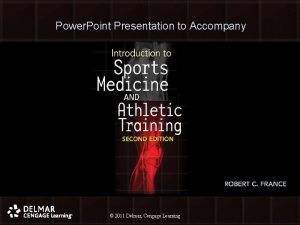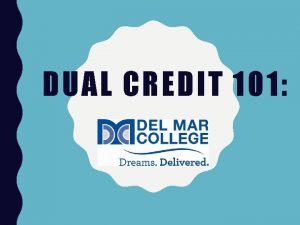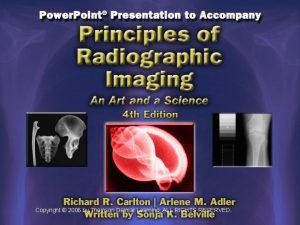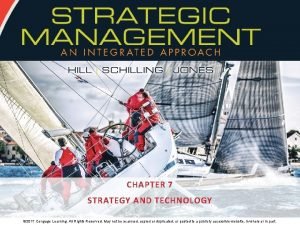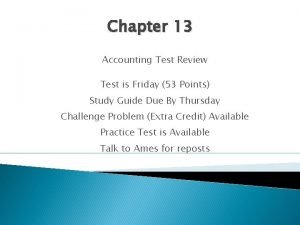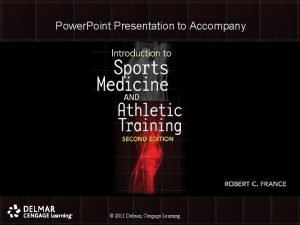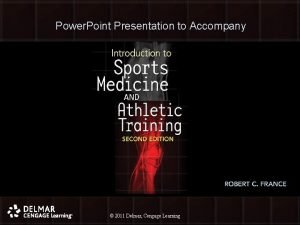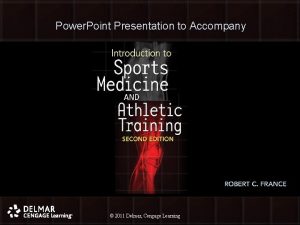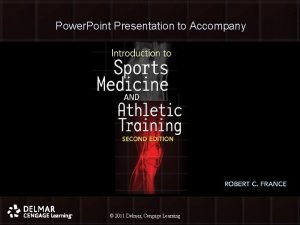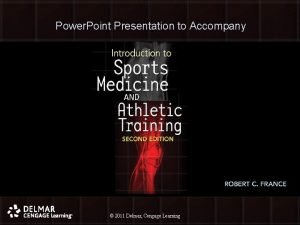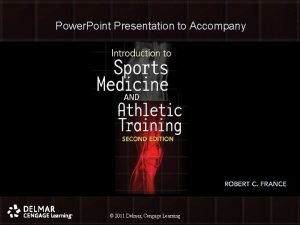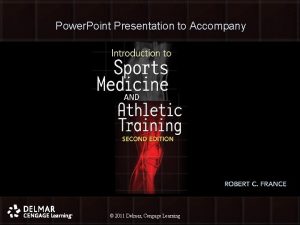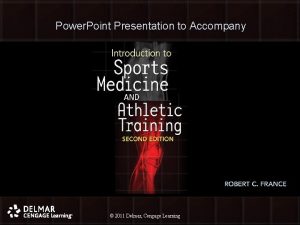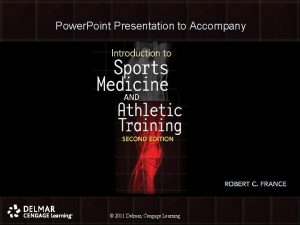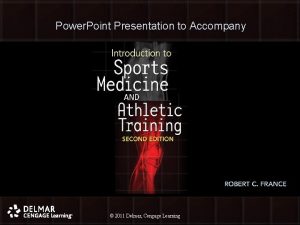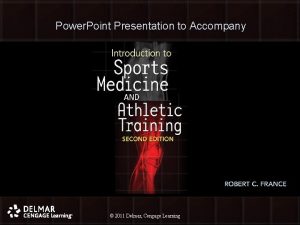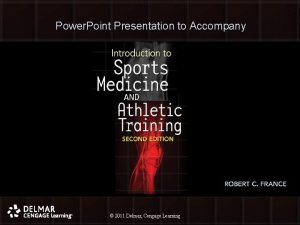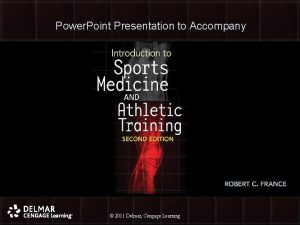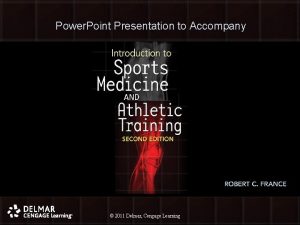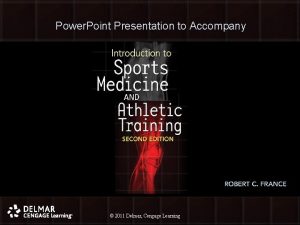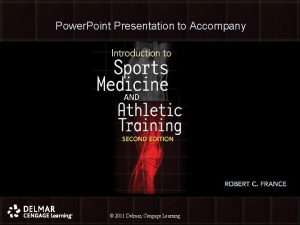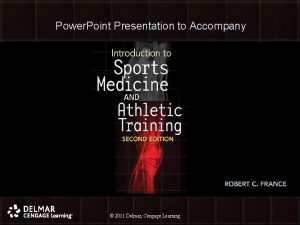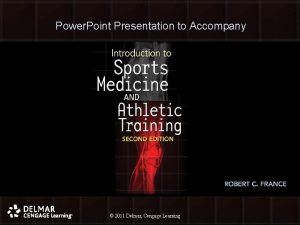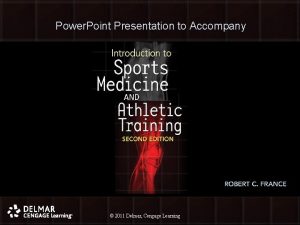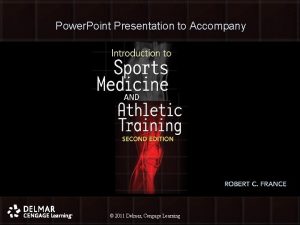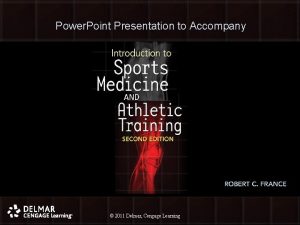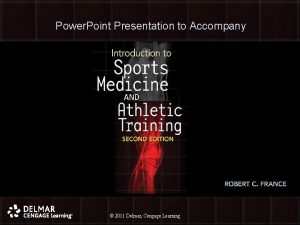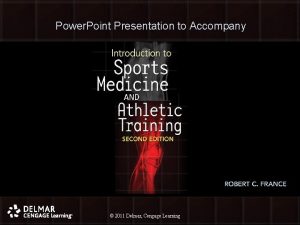Power Point Presentation to Accompany 2011 Delmar Cengage





































- Slides: 37

Power. Point Presentation to Accompany © 2011 Delmar, Cengage Learning © 2010 Delmar, Cengage Learning

Chapter 9 Dietary Supplements and Performance Enhancers © 2011 Delmar, Cengage Learning © 2010 Delmar, Cengage Learning 2

Objectives • Upon completion of this chapter, you should be able to: – Describe dietary supplements and their effect on the body – Give at least four examples of popular dietary supplements on the market today – Explain what performance enhancers do, and why many athletes take them © 2011 Delmar, Cengage Learning © 2010 Delmar, Cengage Learning 33

Objectives (cont’d. ) • Upon completion of this chapter, you should be able to (cont’d. ): – Name the athletic organizations that monitor drug use by athletes – Discuss how education is important to the understanding of supplements and performance enhancers – Explain the athletic code of ethics © 2011 Delmar, Cengage Learning © 2010 Delmar, Cengage Learning 44

Popular Nutritional Supplements • The Dietary Supplement Health and Education Act defines a dietary supplement as: – A product (other than tobacco) intended to enhance the diet, that contains one or more of the following: • • Vitamins Minerals Amino acids Herbs, and/or other botanical substances © 2011 Delmar, Cengage Learning © 2010 Delmar, Cengage Learning 55

Nutritional Supplements (cont’d. ) • Vitamins – Organic (carbon-containing) compounds that are essential in small amounts for body processes – Enable the body to use energy provided by fats, carbohydrates, and proteins – Don’t over use; more does not mean better © 2011 Delmar, Cengage Learning © 2010 Delmar, Cengage Learning 66

Nutritional Supplements (cont’d. ) • Vitamin supplements – Vitamins taken in addition to those received through the diet – Available in concentrated form in tablets, capsules, and drops • According to the FDA, the body cannot distinguish between a vitamin of plant or animal origin (natural) and one manufactured in a laboratory (synthetic) © 2011 Delmar, Cengage Learning © 2010 Delmar, Cengage Learning 77

Nutritional Supplements (cont’d. ) • Vitamin Myths – Food doesn’t contain right nutrients in adequate quantities – Help “bulk up” muscles & enhance performance – Provide needed energy – Can cure anything (including heart trouble, common cold, and cancer) © 2011 Delmar, Cengage Learning © 2010 Delmar, Cengage Learning 88

Nutritional Supplements (cont’d. ) • Minerals – Inorganic (non-carbon-containing) element – Necessary to build tissues, regulate body fluids, and assist in body functions – Contribute energy production as regulators, but do not provide energy – Found in water, and natural foods – Minerals in soil absorbed by plants © 2011 Delmar, Cengage Learning © 2010 Delmar, Cengage Learning 99

Nutritional Supplements (cont’d. ) • Herbal supplements – Some of the world's oldest medicines – 50% Americans believe good for health and wellbeing • Many safe, many are not – FDA considers them dietary supplements • Not regulated • New regulations will give FDA authority to oversee the manufacture of domestic and foreign-made dietary supplements (2010) © 2011 Delmar, Cengage Learning © 2010 Delmar, Cengage Learning 1010

Nutritional Supplements (cont’d. ) • Glucosamine – Used to maintain joint cartilage – Not usually possible to ingest extra w/ food – Treat osteoarthritis & some sports injuries – Take with food – Side effects: stomach problems, heartburn, diarrhea – Types • Glucosamine sulfate • Glucosamine hydrochloride • N-acetyl-glucosamine © 2011 Delmar, Cengage Learning © 2010 Delmar, Cengage Learning 1111

Nutritional Supplements (cont’d. ) • Chondroitin – Naturally found in human and animal cartilage – Proven abilities to treat osteoarthritis – Also used to treat psoriasis and cancers (tests inconclusive) – Appears to be non-toxic w/ no contraindications • Consult if taking anticoagulant medication © 2011 Delmar, Cengage Learning © 2010 Delmar, Cengage Learning 1212

Performance Enhancers • Ergogenic aid – Any agent that enhances energy utilization, including energy production and efficiency © 2011 Delmar, Cengage Learning © 2010 Delmar, Cengage Learning 1313

Performance Enhancers • Research athletes that have been caught using ergogenic aids – What were they using? – How did they get caught? – Did it help them? – Any adverse effects? – What was the punishment? © 2011 Delmar, Cengage Learning © 2010 Delmar, Cengage Learning 1414

Performance Enhancers • Anabolic-androgenic steroids – Manmade substances related to male sex hormones – Available legally by prescription • Treat low amounts testosterone (delayed puberty, impotence, etc. ) – Most users are male © 2011 Delmar, Cengage Learning © 2010 Delmar, Cengage Learning 1515

Performance Enhancers • Athletes take to enhance performance & improve appearance • Orally or injected in cycles • Increased risk of HIV/AIDS or hepatitis • Many psychiatric side effects: aggression, extreme mood swings (manic-like), depression, paranoid jealousy, irritability, delusions, impaired judgment (feeling invincible) © 2011 Delmar, Cengage Learning © 2010 Delmar, Cengage Learning 1616

Performance Enhancers • Adverse effects include liver tumors, cancer, jaundice, fluid retention, high blood pressure, increases LDL and decreases HDL (bad and good cholesterol) • Men: shrinking testicles, reduced sperm, infertility, baldness, develop breasts, increased risk of prostate cancer • Women: grow facial hair, male-pattern baldness, change menstrual cycle, deep voice • Adolescents: halted growth, premature skeletal maturation, accelerated puberty changes © 2011 Delmar, Cengage Learning © 2010 Delmar, Cengage Learning 1717

© 2011 Delmar, Cengage Learning © 2010 Delmar, Cengage Learning 1818

Performance Enhancers (cont’d. ) • Growth hormones – Produced by the pituitary gland – Acts on most organs and tissues in the body – Works by increasing the conversion of amino acids into protein – Allows fat to be used for energy, saving glycogen • Adverse effects include heart disease, impotence, osteoporosis, and death © 2011 Delmar, Cengage Learning © 2010 Delmar, Cengage Learning 1919

Performance Enhancers (cont’d. ) • Androstenedione – Steroid hormone naturally produced in both men and women that is converted to testosterone or to estrogen • Adverse effects include early puberty, premature cessation of bone growth, extreme aggression, mood changes, decreased levels of cardiacprotective HDLs and elevated levels of estrogen © 2011 Delmar, Cengage Learning © 2010 Delmar, Cengage Learning 2020

Performance Enhancers (cont’d. ) • Caffeine – Increased alertness, energy, and improves mood – High levels can cause sleeplessness, anxiety, headache, upset stomach, nervousness, and dehydration – Banned over a certain limit by International Olympic Committee © 2011 Delmar, Cengage Learning © 2010 Delmar, Cengage Learning 2121

Performance Enhancers (cont’d. ) • Creatine monohydrate – Amino acid made by the liver and kidneys – Found naturally in skeletal muscle – Is converted into phosphocreatine in the body • Serves as a storage reservoir for quick energy – Popular in power sports (increases skeletal mm) • Adverse effects include weight gain, muscle cramping, dehydration, gastrointestinal distress, nausea, and seizures, as well as effects on kidney function • May depress body’s own synthesis & may not return to normal © 2011 Delmar, Cengage Learning © 2010 Delmar, Cengage Learning 2222

Performance Enhancers (cont’d. ) • Ephedra – Shrublike plant found in desert regions in central Asia and other parts of the world – Stimulant containing ephedrine – Widely used for weight loss, to boost energy, and to enhance athletic performance • Adverse effects include hypertension, palpitations, neuropathy, psychosis, stroke, memory loss, heartrate irregularities, insomnia, nervousness, tremors, seizures, heart attacks, and death © 2011 Delmar, Cengage Learning © 2010 Delmar, Cengage Learning 2323

Current IOC, NCAA, and Professional Standards • International Olympic Committee Medical Commission – Created in 1961 to deal with doping – Goals: • Protect health, respect for medical and sports ethics, equality for competing athletes • National Collegiate Athletic Association – Drug-testing program – Drug classes: stimulants, anabolic steroids, other drugs © 2011 Delmar, Cengage Learning © 2010 Delmar, Cengage Learning 2424

Current IOC, NCAA, and Professional Standards • Several professional athletic teams have written policy statements concerning the use of banned substances © 2011 Delmar, Cengage Learning © 2010 Delmar, Cengage Learning 2525

Current IOC, NCAA, and Professional Standards • Research NCAA, professional, and Olympic (IOC) rules on banned substances – What are some of the banned substances? – How do they test for it? – What happens if test positive (i. e. punishments)? © 2011 Delmar, Cengage Learning © 2010 Delmar, Cengage Learning 2626

Education for Athletes • The Healthy Competition Foundation – Provides research, information, and strategies designed to eliminate use of performance enhancers • • American College of Sports Medicine International Olympic Committee National Athletic Trainers Association National Collegiate Athletic Association © 2011 Delmar, Cengage Learning © 2010 Delmar, Cengage Learning 2727

Education for Athletes (cont’d. ) • National Federation of State High School Associations • Physician and Sports Medicine • United States Food and Drug Administration • United States Anti-Doping Agency (USADA) • World Anti-Doping Agency © 2011 Delmar, Cengage Learning © 2010 Delmar, Cengage Learning 2828

Ethics in Athletics • Athletic code of ethics – Essential for protecting and promoting the interests of athletics and coaching profession – Ethics are basic principles of proper action – Essential elements are honesty and integrity – Code's primary purpose is to clarify and distinguish ethical practices from those that are detrimental and harmful © 2011 Delmar, Cengage Learning © 2010 Delmar, Cengage Learning 2929

Ethics in Athletics (cont’d. ) • Proper conduct and good sportsmanship refer to standards such as: – Treat other persons as you know they should be treated, and as you would wish them to fairly treat you – Regard the rules of your game as agreements, the spirit or letter of which you should not evade or break – Treat officials and opponents with respect © 2011 Delmar, Cengage Learning © 2010 Delmar, Cengage Learning 3030

Ethics in Athletics (cont’d. ) • Proper conduct and good sportsmanship standards (cont’d. ): – Accept the final decision of any official – Honor visiting teams and spectators as your own guests and treat them as such – Be gracious in victory and defeat – Be as cooperative as you are competitive – Remember that your actions on and off the field reflect upon you and your school © 2011 Delmar, Cengage Learning © 2010 Delmar, Cengage Learning 3131

Ethics in Athletics (cont’d. ) • Athletics and sports in schools serve these purposes: – To teach and instruct students in the rules, fundamentals, and skills of various individual and team sports, and to provide physical training – To provide healthy competition and cooperation within and between schools © 2011 Delmar, Cengage Learning © 2010 Delmar, Cengage Learning 3232

Ethics in Athletics (cont’d. ) • Athletics and sports in schools serve these purposes (cont’d. ): – To develop aspects of good sportsmanship that will enhance each student’s education – To maintain the spirit of true amateur competition © 2011 Delmar, Cengage Learning © 2010 Delmar, Cengage Learning 3333

Ethics in Athletics (cont’d. ) • Guidelines for Coaches – School athletics part of education, not goal itself – Assist students toward developing fullest potential – Behavior of team can reflect coach’s own manner, and the school – Responsible for remaining objective © 2011 Delmar, Cengage Learning © 2010 Delmar, Cengage Learning 3434

Ethics in Athletics (cont’d. ) • Guidelines for players – Respect themselves, coaches, and school – Rivalries encouraged, but disrespect is unsportsmanlike – Comply fully with rulings of officials – Adhere to rules of school, athletic department, and coaches © 2011 Delmar, Cengage Learning © 2010 Delmar, Cengage Learning 3535

Conclusion • The use of dietary supplements and performance enhancers is a controversial issue – It is widely acknowledged that use of supplements and enhancers can do more harm than good – Athletes must understand the associated risks © 2011 Delmar, Cengage Learning © 2010 Delmar, Cengage Learning 3636

© 2011 Delmar, Cengage Learning © 2010 Delmar, Cengage Learning 3737
 Chapter 6:2 interpreting word parts
Chapter 6:2 interpreting word parts 2009 delmar cengage learning
2009 delmar cengage learning Medical terminology chapter 1 learning exercises answers
Medical terminology chapter 1 learning exercises answers 2009 delmar cengage learning
2009 delmar cengage learning Chapter 6 the skeletal system answer key
Chapter 6 the skeletal system answer key Chapter 13 medical math assignment sheet
Chapter 13 medical math assignment sheet Chapter 10 cultural diversity
Chapter 10 cultural diversity Delmar cengage learning instructor resources
Delmar cengage learning instructor resources Things that accompany salvation
Things that accompany salvation Accompany chapter 1
Accompany chapter 1 Dorsal venous network
Dorsal venous network Inkjet printers are considered legacy technology
Inkjet printers are considered legacy technology Presentation topics for students in hindi
Presentation topics for students in hindi Power point presentation design west vancouver
Power point presentation design west vancouver Delmar isotonic
Delmar isotonic Delmar tsi
Delmar tsi Delmar customs broker
Delmar customs broker Thomson delmar learning
Thomson delmar learning Borgify
Borgify Power triangle
Power triangle Power bi power point
Power bi power point Point point power
Point point power Chapter 7:10 respiratory system
Chapter 7:10 respiratory system Cengage differential equations
Cengage differential equations Century 21 bank
Century 21 bank Separation of variables differential equations
Separation of variables differential equations Cengage chapter 7
Cengage chapter 7 Chapter 5 learning exercises medical terminology
Chapter 5 learning exercises medical terminology Cengage learning heart diagram
Cengage learning heart diagram Cengage
Cengage Cengage
Cengage Cengage
Cengage South-western cengage learning
South-western cengage learning Cengage
Cengage Cengage
Cengage Artist
Artist Cengage learning heart diagram
Cengage learning heart diagram Accounting chapter 13 test
Accounting chapter 13 test














